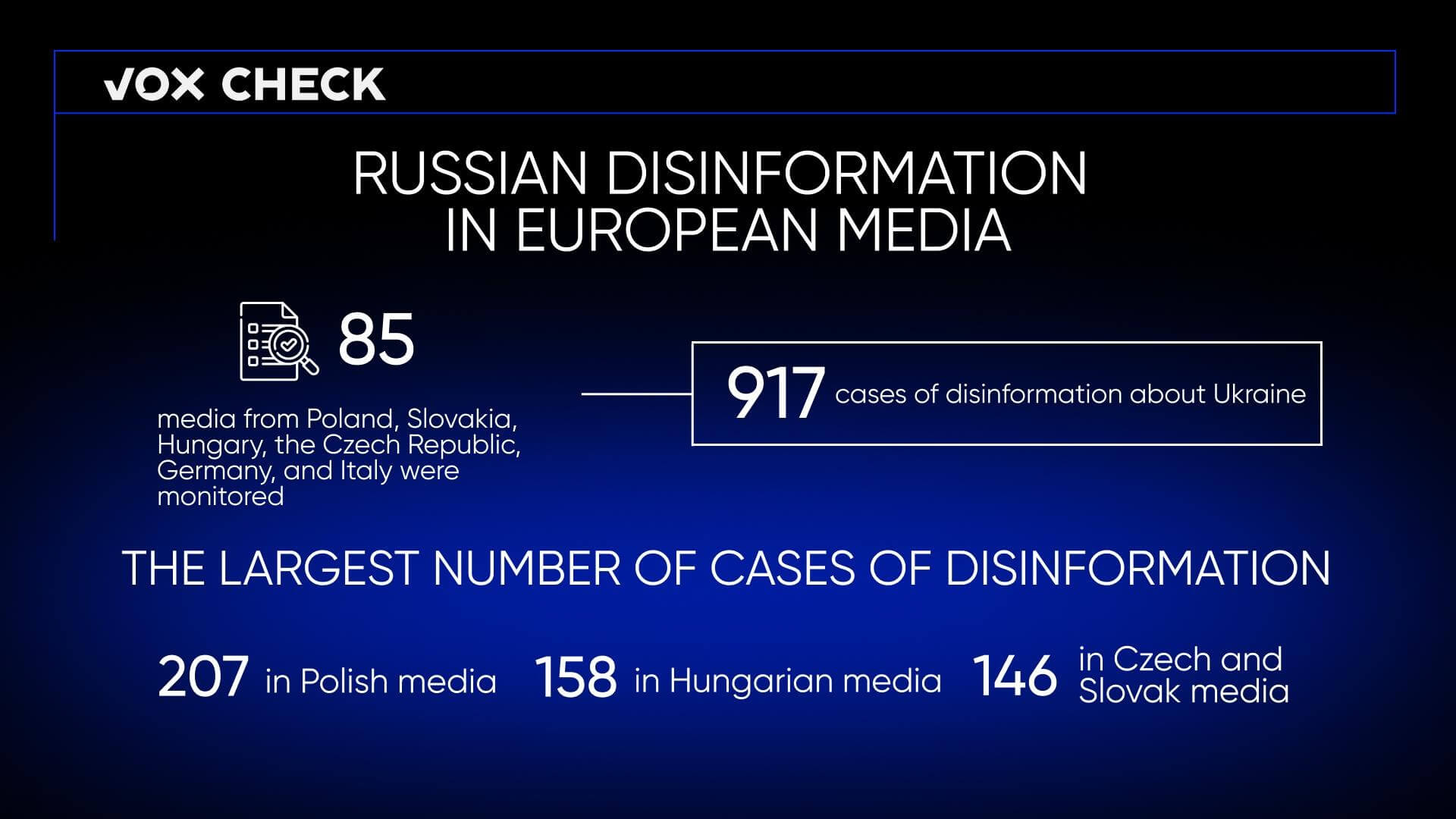In March 2023, VoxCheck monitored 85 media outlets from Poland, Slovakia, Hungary, the Czech Republic, Italy, and Germany and identified 917 cases of disinformation about Ukraine. The largest number of disinformation cases were found in Polish media (207), followed by Hungarian (158), Czech, and Slovakian media (146 each). In March, European media were most active in promoting narratives about Western control over Ukraine, justification for Russian aggression, discrediting the Ukrainian government, as well as “Nazi ideology” in Ukraine.
VoxCheck monitors the media in European countries (Germany, Italy, the Czech Republic, Slovakia, Poland, and Hungary) and analyzes the disinformation narratives about Ukraine spread by these media. For the most part, the detected fakes and manipulations are consistent with the main narratives of russian disinformation campaigns. Every month, the VoxCheck team publishes a report on the monitoring results. All disinformation messages, grouped into narratives and their refutations, will be displayed on the “Propaganda diary” database website.
Poland
During the monitoring of 11 Polish media outlets, we identified 207 cases of disinformation, which we grouped into 27 narratives. The largest number of cases fell into narratives about Western control over Ukraine (37 cases), Nazism in Ukraine (21 cases), and terrorist actions by Ukraine (18 cases).
“NATO will fight to the last drop of Ukrainian blood” — this thesis was voiced as part of the narrative “The West controls Ukraine and uses it for its own purposes”. The authors of such statements are convinced that Western countries are escalating the war. In order to confuse the reader, disinformation media outlets spread several theories that contradict each other. Some write that the escalation of the war is only beneficial to the US, while others say that it is the US and Great Britain or all NATO countries at once. If Ukraine is unable to resist Russia, Polish media predict a struggle “not to the last Ukrainian, but to the last European”.
“Ukrainian Nazism” was a topic that the media tried to find in all elements of Ukrainian culture, starting with the works of Taras Shevchenko, in which propagandists noticed “incitement of interethnic enmity” and ending with the slogan “Ukraine above all“, which allegedly is a copy of Hitler’s “Germany above all.” Often, in the news, the Ukrainian political regime was called Nazi or fascist by default, but this designation was never substantiated.
The image of Ukraine as a terrorist was formed in the media through both old and new fakes. For example, in publications, they repeatedly quoted the Russian position that strikes on Ukraine’s energy infrastructure are allegedly a response to the “act of terrorism” on the Crimean Bridge in October 2022. Among the new justifications for Russian aggression were accusations against Ukraine of organizing terrorist attacks in border regions of the Russian Federation and attempting an assassination of pro-Russian leaders in Transnistria.
Fakes about the existence of “black transplantology” (10 cases) in Ukraine, both at the front and in the rear, were also spread in the Polish media space. A similar topic — experiments on Ukrainians — was promoted as part of the narrative about US military-biological laboratories in Ukraine (6 cases).
Slovakia
As a result of monitoring 13 media outlets in Slovakia, we found 146 cases of disinformation that can be divided among 19 narratives. The most common narratives were those about the justification of Russian aggression (28 cases), Western control over Ukraine (25 cases), and Ukraine’s inevitable defeat in the war (21 cases).
As part of the narrative of justifying Russian aggression, propagandists spread Putin’s statement that Western countries were preparing a plan to exterminate Russia, similar to the plans of Nazi Germany to destroy Slavic peoples. Pro-Kremlin media also resorted to a classic propaganda method: instead of discussing their own crimes, they accused other countries of all “sins.” In one publication, they mentioned the operations of NATO countries in Vietnam, Iraq, Afghanistan, Syria, and Libya. This list is supposed to discredit the West and demonstrate its hypocritical support for Ukraine against Russian aggression.
By promoting the narrative about Western control, Slovakian media repeated the idea of a “pro-Western coup in Ukraine in 2014”, which turned Ukraine into a “protectorate” and forced it to fight against Russia. Now, Ukraine is allegedly being forced to abandon peaceful negotiations because the war brings “crazy profits” to American Democrats and weapon manufacturers.
Once again, Ukraine is being predicted to lose the war. In March, it was claimed that Ukraine had lost hundreds of thousands of soldiers killed, and at the same time, the West had run out of resources to support the war. Some individual battles were also commented on, such as Bakhmut, which, if captured by Russia, would allegedly result in the capture of almost the entire Left-Bank Ukraine.
The narrative about the discrediting of the Ukrainian authorities became widespread (12 cases). The fake news creators primarily focused on information attacks against President Zelenskyi, calling him a “clown, comedian, drug addict, fascist” and predicted that he would flee the country after the military defeat. Additionally, there were mentions that the “Ukrainian propaganda machine” conceals any negative news and instead fabricates war victories and heroes to support the fighting spirit of Ukrainians.
During this period, there were also calls for Ukraine to immediately start peace negotiations and compromise with Russia (5 cases) and accusations that the transfer of depleted uranium ammunition to Ukraine would lead to a nuclear catastrophe (7 cases).
Hungary
We monitored 13 Hungarian media and found 158 cases of disinformation, which we divided into 16 narratives. The most widespread were narratives about Western control over Ukraine (30 cases), the justification of Russian aggression (25 cases), and the discrediting of the Ukrainian authorities (22 cases).
Hungarian media follow in the footsteps of Russian channels, claiming that Western countries have made Ukraine “anti-Russia” and that the aggressor is not fighting Ukrainians but the West. Furthermore, according to their version, the West seeks to escalate the conflict by moving the war to Belarus or using a nuclear component, including depleted uranium ammunition supplied to Ukraine. Ukrainian politicians, including the president, were accused of working for the Western military-industrial complex.
In March, Russian aggression was justified using typical patterns: restoration of historical justice, reclaiming “historical territories” of Russia, destruction of Donbas over the past 8 years, threat of genocide, placement of US bases in Romania, Poland, and the question of possible Ukrainian accession to NATO. These media outlets attempt to convince their audience that Russia had no choice: if Russia had not started the invasion on February 24, 2022, it would have later had to wage war against the entire West, but under worse conditions.
The main theme used to discredit the Ukrainian government was combat operations and mobilization. In several publications, it was written that Ukraine does not value its people and therefore sends unprepared or unfit fighters to the front lines, such as minors or elderly people. At the same time, Zelenskyi was criticized for constructing a “parallel reality” as an actor in which the population knows nothing about negative events in the country. The Ukrainian state was also called dead, claiming that 40% of its cities and infrastructure had been destroyed during the year of the invasion.
A widespread narrative was that military aid to Ukraine would prolong the conflict and will lead to a world war (12 cases). In addition, the disinformation campaign mentioned a narrative about Ukrainians who want to join Russia (8 cases) — it consisted of repeating fakes about the “legitimacy” of Russian pseudo-referendums in Crimea in 2014 and in the Zaporizhzhia, Kherson, Donetsk, and Luhansk regions in 2022.
Czechia
As part of monitoring 12 Czech media outlets in March, we identified 146 cases of Russian disinformation and 19 narratives. We identified the most messages within the narratives about Nazism in Ukraine (26 cases), discrediting Ukrainian government officials (24 cases), and Western control over Ukraine (19 cases).
Czech media recalled the Russian thesis “since 2014, Ukraine has been overrun by Nazis”. Supposedly, this is manifested in the use of Nazi greetings, holding torchlight processions in honor of Nazi criminals, and the creation of Nazi battalions that train young people for extremist and terrorist acts in special camps. Separate attention was also paid to discrediting the 10th Separate Mountain Assault Brigade “Edelweiss” in the Armed Forces of Ukraine. Articles claimed that a German unit during World War II had a similar honorary name. However, the media ignored the fact that the edelweiss flower symbol is not Nazi and that there were even units with the same name in the Russian army.
The main goal of the information attacks against the Ukrainian government was Volodymyr Zelenskyi. He was called an opponent of peace and “crazy” because he supposedly called on NATO countries to send their soldiers to fight in Ukraine. Czech media also quoted Alexander Lukashenko, who accused the Ukrainian leader of sabotage on Belarusian territory. Overall, the fake news creators describe the political situation in Ukraine as almost revolutionary: literally from day to day, either the Russians themselves or opposition Ukrainians will remove the “usurper Zelenskyi” from power, so the president will be forced to flee to Western countries.
As part of the narrative about the control of the West, the Russian-Ukrainian war was referred to as a proxy conflict between Russia and NATO. In doing so, Ukraine was being deprived of any subjectivity in the war and viewed as a “pawn” in a larger geopolitical game.
In addition, in the Czech Republic, a narrative about historical events in Ukraine was actively spread (8 cases). For example, in one publication, a statement by a pro-Russian Romanian senator was repeated, claiming that some Ukrainian territories are historical lands of Romania that need to be reclaimed. Traditional Russian propaganda theses were also spread, such as the claim that Russians have lived in Kharkiv and Donbas for centuries and, therefore, these territories should belong to Russia.
Germany
In 19 German media, we identified 126 cases of disinformation and 20 narratives that correspond to these cases. The largest number of cases were related to the West’s control over Ukraine (27 cases), alleged war crimes committed by the Ukrainian army (15 cases), and discrediting representatives of the Ukrainian government (13 cases).
To support the narrative about the West’s control over Ukraine, the media repeatedly quoted Russian politicians. The words of the Russian Foreign Minister about the Western countries’ interest in supporting Ukraine only to weaken Russia and China were cited, as well as the statement of the Chairman of the State Duma that the US is weakening the European economy and ensuring its own hegemony through the war. The theme of conflicts between Europe and the US was also mentioned in other publications, such as the fake about Germany being used by the “Anglo-Saxons” in their confrontation with Russia, as was the case in the two previous world wars.
The demonization of the Ukrainian Armed Forces in German media is happening through the spread of disinformation about the “war crimes of the Armed Forces of Ukraine”. According to the disinformers, the “evidence” of these crimes includes shelling both of Russia’s border regions and the occupied territories of Ukraine in the Donetsk and Kherson regions. All civilian population and objects such as residential buildings, schools, kindergartens, hospitals, shopping centers, etc. are listed as victims of these shelling attacks. Meanwhile, true war crimes committed by Russian occupiers were not reported in the media that were included in the monitoring.
Ukrainian authorities are most often discredited with fakes about the catastrophic situation on the front lines and the terrible treatment of soldiers in the Armed Forces of Ukraine by their commanders. In one article, it was claimed that the command intentionally designates deceased soldiers as missing in order to avoid paying compensation to the military personnel’s relatives. The discrediting campaign also targeted Volodymyr Zelenskyi — this time, the media fabricated that French animators created a series about the Ukrainian President, in which he started a war to improve his own ratings and capital. In reality, the authors of the animation could not be identified, and it is most likely a coordinated Russian attack.
“The oppression of the Orthodox Church in Ukraine” (13 cases) became another massive narrative in German media. The narrative consisted of fakes about the discrimination of parishioners of the Russian Orthodox Church under the name UOC MP and the violation of freedom of religion.
Italy
In March, we identified 134 cases of disinformation in 17 Italian media outlets. All cases were divided into 29 narratives, the largest of which were Russia’s war with NATO or the “collective West” (19 cases), Western control over Ukraine (18 cases), and Ukraine’s defeat in the war (9 cases).
To justify its military failures in Ukraine, Russia has repeatedly claimed that it has been fighting not only the Ukrainian military but also the entire NATO bloc or the so-called “collective West”. Some Italian media have fallen under Russian influence as well. The Russian-Ukrainian war is referred to as nothing less than a NATO-Russia proxy conflict. At the same time, Ukraine’s role in this geopolitical confrontation is to “sacrifice” its own population for the sake of foreign interests. And according to disinformation reports, these sacrifices are so high that the NATO alliance is increasingly forced to engage in combat operations.
The Italian media explained “Western control over Ukraine” as the enrichment of Western countries at the expense of supplying Ukraine with weapons and using the war to isolate China and Russia. Additionally, the United States allegedly has a separate interest in weakening Europe as an economic competitor. Due to these reasons, the West is forcing Ukraine to prolong the conflict, and Ukraine itself will be forced to pay off huge debts for the aid provided.
Propagandists also wrote about the “guaranteed” defeat of Ukraine in the war, citing high human losses and a lack of weapons, particularly in battles in Donbas. Furthermore, they assure that the West will no longer support Ukraine’s struggle since its arsenals are depleted. The “conclusion” that Ukraine has permanently lost its chances to regain its occupied territories and the only way to survive is to make concessions to the aggressor follows from this.
It’s worth noting a few more narratives – “The crisis in Europe and the world started because of Ukraine” (8 cases) and “Ukraine is a terrorist state” (8 cases). The first is made up of fake stories about anti-Russian sanctions that had a “devastating” impact on the EU economy but could not destabilize Russia. And with the help of the second narrative, Ukraine was unreasonably accused of undermining the “Nord Stream” gas pipeline, terrorizing civilians in Russia, and using chemical weapons.
Attention
The authors do not work for, consult to, own shares in or receive funding from any company or organization that would benefit from this article, and have no relevant affiliations



